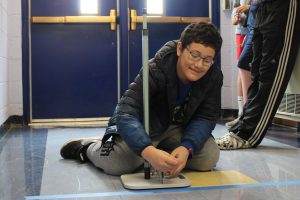 Sixth grade student John Walsh worked diligently on his straw rocket. As part of his middle school engineering class, he tried a variety of designs to see how far the rocket could go, including adding popsicle sticks.
Sixth grade student John Walsh worked diligently on his straw rocket. As part of his middle school engineering class, he tried a variety of designs to see how far the rocket could go, including adding popsicle sticks.
“I’ve learned that the best way is to keep it light and have clay in a point at the top of the straw,” he shared. “There are a lot of strategies, including what degree to send it off at. I put it lower so that it wouldn’t hit the ceiling.”
“Before working on distance, we focused on accuracy,” shared Beverlie Fevrier. Students aimed at specific targets to test their ideas.
“The class makes you more independent and helps you realize that you can do things on your own,” she added. This is because “you have to make it by yourself. It all depends on how you do it and the techniques you use.”
 Charles Davis, the students’ tech education teacher, shared that the project is an extension of the aerodynamics unit, where students made paper helicopters and airplanes, and studied theories behind aerodynamics. “My goal is to keep the students engaged learning science, math and technology skills,” he shared, adding that he hopes units like this help spark student’s interest in the topic.
Charles Davis, the students’ tech education teacher, shared that the project is an extension of the aerodynamics unit, where students made paper helicopters and airplanes, and studied theories behind aerodynamics. “My goal is to keep the students engaged learning science, math and technology skills,” he shared, adding that he hopes units like this help spark student’s interest in the topic.
Walsh looks forward to the next engineering class in seventh grade. “This unit was a lot of fun,” he said.


